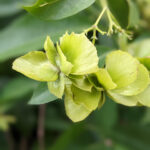Top Ten Herbs
as voted on by the HSA membership in attendance at the Education Convention in Pittsburgh last year.
Sweet basil – voted as the most popular herb. The botanical name is Ocimum basilicum. The genus name Ocimum is actually not even Latin – it is a Greek word which essentially means an “aromatic herb.” And aromatic it certainly is! The specific epithet basilicum comes from the Greek word “basilicon” and it means “kingly” or “royal.” In time it was confused with the word “basiliscus” or basilisk, the mythical king of serpents – a not so nice creature in any regard. Thus in the language of flowers basil came to signify hatred. A sad thing that, but there is also a lovely story written by John Keats called Isabella or The Pot of Basil, which is tragic but puts basil in a better light. In the story Isabella’s lover is beheaded by her brothers and in grief she takes the head and puts it in a pot and plants basil on top, which she then waters with her tears. Basil then becomes a sign of love. We all love basil, not hate it, don’t we?
Rosemary – my personal favorite herb is known in botanical terms as Rosmarinus officinalis. Rosmarinus comes from two Latin words – ros meaning dew or spray and marinus meaning sea. In the Mediterranean it is often found clinging to rocky sea cliffs and may survive only on the dew or spray that it receives from the sea. Some think that the name is in honor of the Virgin Mary and there are many tales that connect her to the plant – especially that the flowers of rosemary are blue (but some aren’t) because they became that color when she draped her blue cloak upon a rosemary plant to dry. The term officinalis refers to the fact that this plant was part of the medieval apothecaries in monasteries –meaning simply that it is an important medicinal plant. Many others of our favorite herbs have this appellation as well. In the floral language rosemary signifies remembrance – rub a few leaves with your fingers and you’ll actually have a lasting remembrance until you wash them. The fragrance of rosemary is also supposed to enhance the brain’s memory. “There’s rosemary, that’s for remembrance. Pray thee love, remember!”- Ophelia in Shakespeare’s Hamlet.
Greek Oregano – is the only oregano on the list and thus I assume that it is the most popular of the oreganos. I believe that it is the one most commonly found in dried herb bottles. Its botanical name is Origanum vulgare var. hirtum. Origanum is Greek for “beautiful mountain,” but some translate it as “joy of the mountains,” and vulgare simply means “common” in Latin. Hirtum means hairy, referring to the small hairs that cover the leaves. Many varieties of oregano grow in the mountainous regions of the Mediterranean, but some say the name comes from the growth habit of many oreganos – mounding likely little mountains themselves. In the language of flowers it signifies “blushing” – perhaps because it was common in Greece and Rome to crown young couples with wreaths of the blossoms and it was said to allay any “blushing.” It is also a common ingredient in love potions, possibly to relieve bashfulness.
Common Sage– or culinary sage goes by the botanical name of Salvia officinalis. The term Salvia essentially means “to save” – such as in the similar word salvation. Some say that it derived this name as it was used to cure many ills. In the floral language it is said to signify domestic virtue. In olden days it was believed that sage would only thrive in the garden where the mistress is the master or in the gardens of the wise – thus its association with wisdom as well. Members of HSA who reach the level of 50 years of membership are honored as golden sages for their dedication and wisdom.
Bay Laurel – or sweet bay is known as Laurus nobilis. It is believed that the name Laurus was applied to the plant by the Romans, but it came from the Celtic Laur, which means green. This plant was dedicated to Apollo and was worn as a sign of honor or victory by poets, warriors, and athletes alike. Thus from that tradition it likely gained the term nobilis, which simply means noble, and its symbolic stature of “glory.” This plant, so steeped in tradition, is wonderful for seasoning even the simplest of stews.
Common Thyme – is a common name that is a strict translation of this plant’s Latin name – Thymus vulgaris . Thymus is the name that is applied to all plants in this genus and I can find no translation, so I can only assume that it was a name that was long ago applied to this plant in particular (If I am wrong, please let me know). As mentioned in the previous article under Greek Oregano – Origanum vulgare , vulgare , or in this case the form vulgaris , simply means common. This thyme is commonly found growing from the far western Mediterranean through the Italian peninsula. It is a low, shrubby plant with small and very aromatic leaves and has long been utilized for its culinary and medicinal benefits. It contains a substance known as thymol which has many medicinal uses – especially as a topical antibiotic. As you likely know from perusing the tables at the recent Herbal Forum plant sale, there are many other types and cultivars of thyme that are now available. Some forms of common thyme that you will come across are French (the most common of the common thymes), English (having a broader leaf than the French), silver, golden, and a passel of variegated forms. The citrus flavored thymes belong to Thymus X citriodorus and are excellent culinary thymes as well, but the creeping thymes are for the most part best suited for ornamental purposes.
Chives – are the famed herbal cousins of the onion. In particular here we are talking about what are commonly known as onion chives – Allium schoenoprasum . The term Allium is Latin for garlic, but its roots can be traced back to the Celtic word all , which translates as “pungent” or “stinky”. The term schoenoprasum is derived from the Greek word for leek while the common name of “chives” is a corruption of the Latin cepa , which means onion. We can grow onion chives here, but they don’t thrive nearly as well as their Chinese cousin the garlic chives – Allium tuberosum , with tuberosum referring to the tuberous or bulbous bases. These have flat, pungently scented and flavored leaves and white flowers in fall, while the onion chive leave are milder, quill shaped, and the flowers are lavender and appear in the spring. You should always have one of these on hand to top your baked potatoes.
Dill – is one of the longest cultivated and most beloved of herbs. Its botanical name is Anethum graveolens. Anethum is a Latin term that was derived from the Greek ano (upward ) and theo (I run) in reference to the plant’s quick upward growth while graveolens means very aromatic or strong-smelling. The common name of dill is believed to have derived from the Norse verb dilla , which means to lull and is a reference to the plant’s carminative (look this word up if you don’t know it) qualities. Dill was utilized by the ancient Egyptians and seems to have become beloved by all cultures whose path it crossed. How else would a plant whose origins are in the Mediterranean go by a common name from Scandinavia?
Parsley – is another plant native to the eastern Mediterranean. Its generic name Petroselinum comes from the Greek words petros , meaning rock and which alludes to its native habitat of cliffs, rocks, and old walls, and selinon , meaning celery – a close cousin. The specific name crispum refers to the “crisped” leaves of many cultivars. The curly leaf variety is variety crispum , (Petroselinum crispum var. crispum ) the Italian flat-leaf is variety neapolitanum , and the Hamburg or turnip-rooted is variety tuberosum . Parsley is very rich in vitamins and is a breath sweetener, so the next time you encounter a bit on your plate, chew on it at the end of your meal.
Lavender – is the final, but definitely not the least, of the ten most popular herbs. Its botanical name Lavandula comes from the Latin lavare , which means to wash. The Romans and Greeks both used lavender flowers to scent their baths and thus derived both its botanical and common names. We still love to use lavender in this way for its calming, refreshing aroma. There are many types and varieties available, but my two favorites for growing in our area are sweet lavender, Lavandula x heterophylla (hetero meaning of two or more shapes and phylla meaning leaves) and Spanish lavender, Lavandula stoechas (stoechas from the Stoechades, now the Isles d’Hyeres, off the southern coast of France). Both of these are blooming at present and are such a delight to have in the gardens at Festival Hill and my own gardens at home. I hope that you picked up a few at the plant sale!









